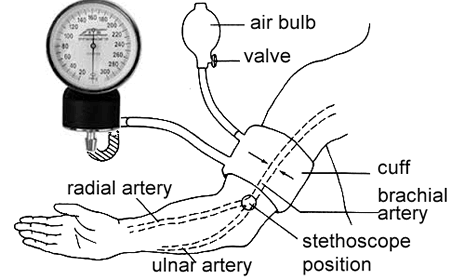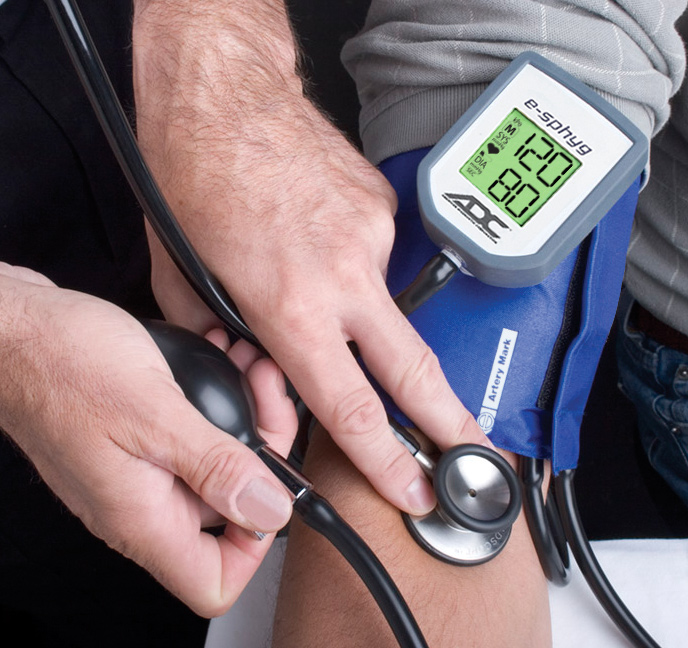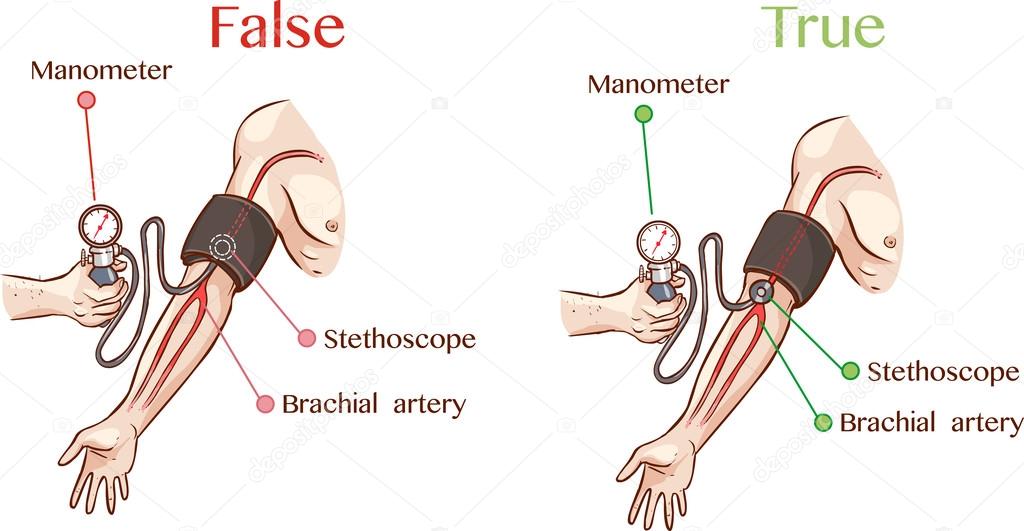However there is little scientific evidence to quantify the BP difference between the BP measurements taken with. The standard for blood pressure cuff placement is the upper arm using a cuff on bare skin with a stethoscope placed at the elbow fold over the brachial artery.
The following steps must be followed with an obese arm for blood pressure measurement.

. The cuff should be placed snugly around the upper arm and the bladder of the cuff should cover at least 80 of the arms circumference. It has been recommended that the stethoscope should be placed gently over the brachial artery at the point of maximal pulsation and held firmly and evenly but without excessive pressure16in clinical practice the stethoscope is sometimes placed under the cuff but traditionally and more usually outside the cuff over the brachial artery in the. Blood pressure can be measured in the arm leg or even the foot says Michael J.
Blaha MD MPH director of clinical research at the Johns Hopkins Ciccarone Center for the Prevention of Heart Disease in Baltimore. Which is used to estimate systolic blood pressure SBP and diastolic blood pressure DBP12 Moreover standardized measurements of BP are based on auscultation method and highly dependent on pres - sure changes of the cuff bladder to the brachial artery so that the placement of the cuff and stethoscope is critical5-813. A blood pressure cuff is composed of a cuff or sleeve a meter an inflation bulb and hoses that connect everything together.
Specifically it is recommended that the center of the bladder used for BP measurement should be placed over the course of the brachial artery3 6 9 10Interestingly although the theoretical principle of this recommendation seems reasonable to our knowledge there are no published studies available to support such a recommendation. Find the radial pulse and the place the artery arrow on the cuff over the radial artery. I actually had to do this when I went through my home health rotation a lot dt IVsPICC lines that pts would have.
A blood pressure cuff is a piece of medical equipment used to measure an individuals blood pressure. This is your diastolic pressure. This is known as----- 2.
Once you understand why you need a stethoscope when taking blood pressure it is also essential to be familiar with how it should be placed. It should always be placed directly on the skin to give an accurate reading. Have a physician compare the upper arm to the forearm and wrist measurements.
What is the best position to take blood pressure. A built-in stethoscope bell be sure to position the cuff so the bell is over the artery. Placement of the stethoscope on the left facing the patient inter-costal space between rib 2 and 3 will allow for the sound produced by the -----valve to be heard.
If your answer is. Different home monitors recommend slightly different distances. The diaphragm must be placed flat against the skin on the arm of the patient.
It contains several individual parts and may need to be assembled prior to use. Of the elbow but with good skin contact. You place the stethoscope on the skin over the artery.
During the blood pressure measurement the doctor will place the stethoscope on the brachial artery which is in your arm to listen to your blood flow. Place your stethoscope over the flat part of the inner wrist closest to the radial artery side. Make sure the arm is not a conical shape.
The circumference of the diaphragm must be just underneath the cuff and be positioned over the artery. Let the pressure fall 2 millimeters or lines on the dial per second while listening for your heart sounds. The arm being tested should be relaxed and the blood pressure cuff should be at heart level.
Rest quietly and wait about one to two minutes before taking another. Then place your stethoscope and take the blood pressure how you normally would. Some experts suggest that if the opposite arm is unavailable you can have your blood pressure taken in the surgery arm using a manual blood pressure cuff and stethoscope as this does not pump as tight and is quicker.
This only applies if your pressure is taken the old-fashioned waywith a sphygmomanometer. Position the bell of the stethoscope over where you felt the pulsation of your brachial artery. In clinical practice it is sometimes placed under the cuff but more usually outside the cuff on the antecubital fossa.
This is your systolic pressure. I work in pych and have a number of patients that require creativity in getting vital signs this is how I take blood pressure on the forearm with manual equipment Place the BP cuff around the forearm just below the elbow. Sit in a chair with back support and place your feet flat on the ground.
Note the reading when you first hear a heartbeat. Do not wrap the cuff too tight. For the following blanks you must include artery in your answer ie.
As you release air from the cuff you listen for the sound of the blood as it starts to flow through the artery again. Know where the stethoscope is supposed to be placed on your arm. Your patient has a blood pressure of 142100.
Place the inflatable blood pressure cuff securely on the upper arm. Measuring the blood pressure of each arm can help ensure an accurate test. A blood pressure cuff should never be placed over clothing.
The reading on the gauge when blood flow is first heard is the systolic pressure. Spncharlotte 16 Posts May 29 2011. When measuring blood pressure BP using the auscultation method a stethoscope is commonly used.
The lower end of the blood pressure cuff is placed 2-3 cm above the antecubital fossa which should be at approximately the same vertical height as the heart while allowing room for the stethoscope. Use a cuff size large enough for the obese arm. The bottom edge of the cuff should be positioned approximately one inch 2-3 cm above the antecubital fold.
It is recommended that IVs are placed in the arm on the opposite side of your surgery if possible. Place the cuff over the bare upper arm with the artery mark positioned directly over the brachial artery. The reading when blood flow can no longer be heard is the diastolic pressure.
The patient should be sitting with. Know where the stethoscope is supposed to be placed on your arm. If so use another location.
Palpate for a radial pulse. Note when you no longer hear the beating sounds. Wrap the end of the cuff not containing the bladder around the arm snugly and smoothly and engage adhesive strips.
Dont cross your legs. There should be a 2 to 3cm space for the stethoscope between the lower end of the cuff and the antecubital fossa unless this would require an undersized cuff. Your patient has a blood pressure of 142100.
Partially tuck the bell of the stethoscope under the blood pressure. Blood Pressure Cuff Placement For the best cuff placement it should be wrapped around the upper arm just above your elbow bend. Interval between repeated measurements.
The Omron home monitor I recommend states the bottom of the cuff should be about 12 above the elbow bend.

How To Appropriately Measure Blood Pressure In A Practice Setting Youtube

How To Take Blood Pressure American Diagnostic Corporation

How To Take Blood Pressure Carrington College

Ppt This Demonstrates The Location Of The Cuff And Placement Of The Stethoscope For Taking Blood Pressure Powerpoint Presentation Id 632605

Blood Pressure Symbol Vector Illustration True False Stock Vector Image By C Corbacserdar Gmail Com 109512494
Vital Signs Client Care Nursing Part 5

0 comments
Post a Comment